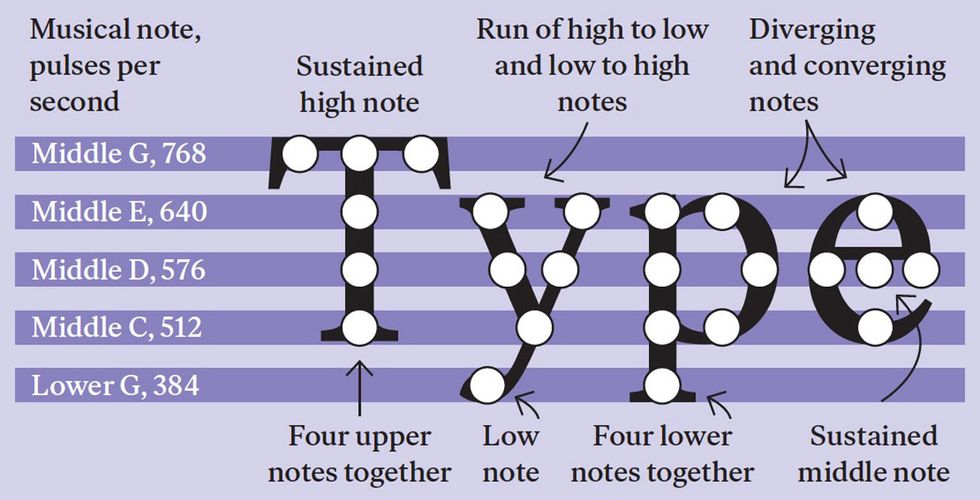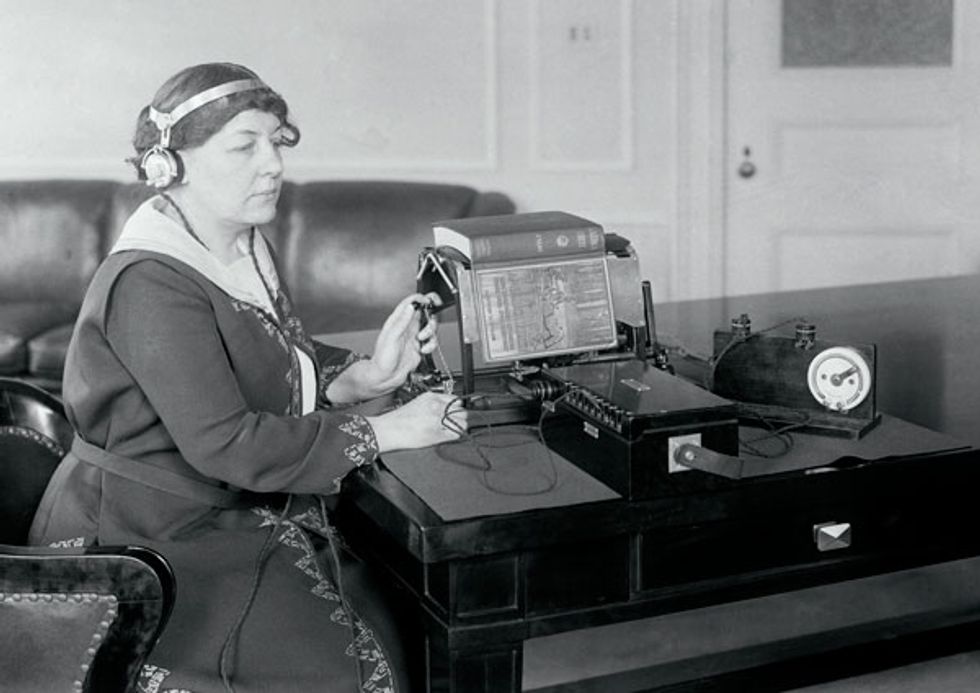A Century Ago, the Optophone Allowed Blind People to Hear the Printed Word
The optophone turned letters into tones and was the proof of concept for optical character recognition
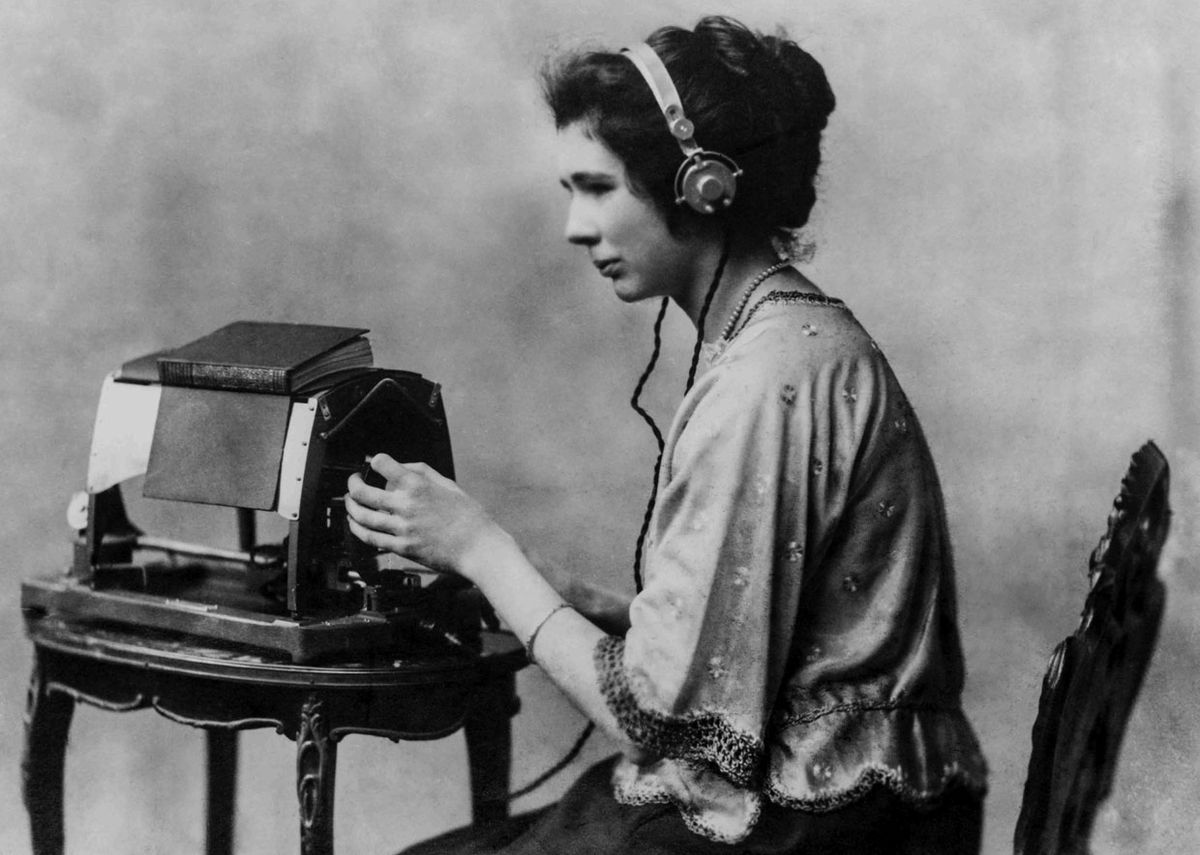
Mary Jameson began using the optophone in 1918. By 1972, she could read 60 words per minute.
On 25 June 1912, the Irish writer, inventor, and physicist Edmund Edward Fournier d'Albe demonstrated a curious machine at the Optical Society Convention in London. He called it an “exploring optophone," and his remarkable claim was that it allowed people who were completely blind to “hear" light.
The optophone's sensing apparatus—a cell that relied on the photoelectric properties of selenium—was housed in a long, slender wooden box, to which was attached a pair of headphones. While holding the box, the user would listen for modulations in tone as the cell detected light; the device was surprisingly good at distinguishing between light and dark spaces and even the flickering of a match. Fournier d'Albe pitched it as an important new mobility tool that would allow people who were blind to safely explore their environments. In a newspaper interview, the inventor went as far as to hail it as “the first stage in making the eye dispensable."
News of the exploring optophone spread rapidly among blind communities as well as scientists. Fournier d'Albe exalted in the praise—until, that is, he received a note from a well-known solicitor named Washington Ranger. Ranger was blind, and his critique was blunt: “The blind problem is not to find lights or windows, but how to earn your living."
Chastened, Fournier d'Albe went back to the drawing board. This time, his goal was to design a machine that would translate text from ordinary books and newspapers into sounds that the user could interpret as words. He realized that printed letters each have a unique visual ratio of white to black on the page, and that this ratio could be picked up by a photosensitive cell and translated into a series of corresponding sounds. By learning the audible alphabet, a user would be able to read a book, albeit one letter at a time.
How the Optophone Translated Text Into Tones
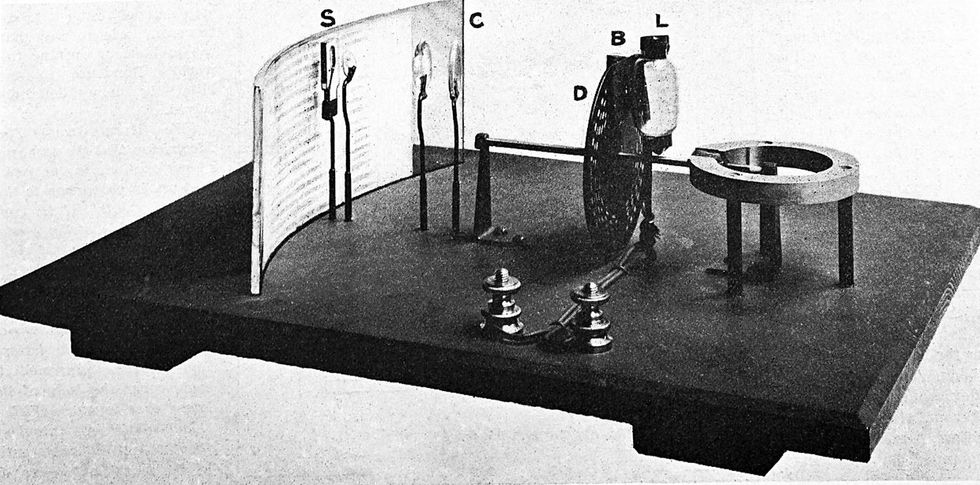
Fournier d'Albe demonstrated a crude prototype of the reading optophone in September 1913. Once again, his work was greeted by media acclaim. The optophone would enthrall and frustrate him for the rest of his life. Although it never saw commercial success, we would be wrong to label it a failure or a technological dead end. Other inventors continued to adapt and refine the technology, and the concept of automatically scanning text helped open the door to optical character recognition.
Fournier d'Albe was born in London in 1868 and educated in Germany. Although he is largely forgotten today, during his own lifetime he attained fame and notoriety in a number of unrelated areas, including the physical sciences, spiritualism, linguistics, and pan-Celtic unification. In a 2017 article, historian Ian B. Stewart noted that Fournier d'Albe's theory of a hierarchical universe later influenced Benoit Mandelbrot's work on fractals. Fournier d'Albe was also a pioneer in the nascent field of television and the first to transmit an image wirelessly—a 600-dot photo of King George V on Empire Day in 1923, which took 20 minutes to send. Stewart pointed out that Fournier d'Albe, as a member of the fin-de-siècle generation, saw no problem with unifying his diverse interests through his embrace of the social sciences. But the work he was most proud of was the optophone.
He came to his invention by a circuitous route. In 1893, at the age of 25, Fournier d'Albe took a job writing book abstracts for The Electrician magazine and then Physical Society. This work exposed him to a world of cutting-edge scientific discoveries and exceptional thinkers. During his lifetime, he would befriend H.G. Wells, W.B. Yeats, the chemists Wilhelm Ostwald and William Ramsay, physicist George Johnstone Stoney, television pioneer A.A. Campbell-Swinton, and the magician and spiritualist Harry Houdini.
In 1907, Fournier d'Albe decided to pursue a career in physics. Through his impeccable contacts, he secured a post as an assistant lecturer at the University of Birmingham under the renowned physicist Oliver Lodge. Lodge recommended that Fournier d'Albe focus his doctoral research on selenium.
Selenium's unusual photoelectric properties first surfaced in experiments at the Telegraph Construction and Maintenance Co. in 1873, which showed that the metal's resistance changed according to the intensity of light falling on it. The resistance was highest when the sample was enclosed in a dark box. Removing the box's cover caused the conductivity to jump. Selenium (named for the Greek goddess of the moon, Selene) would soon become known as a wonder material, and several inventors attempted to exploit it. Most famously, Alexander Graham Bell used the metal in his photophone of 1880, a telecommunications device that relied on modulated light to transmit a wireless signal.
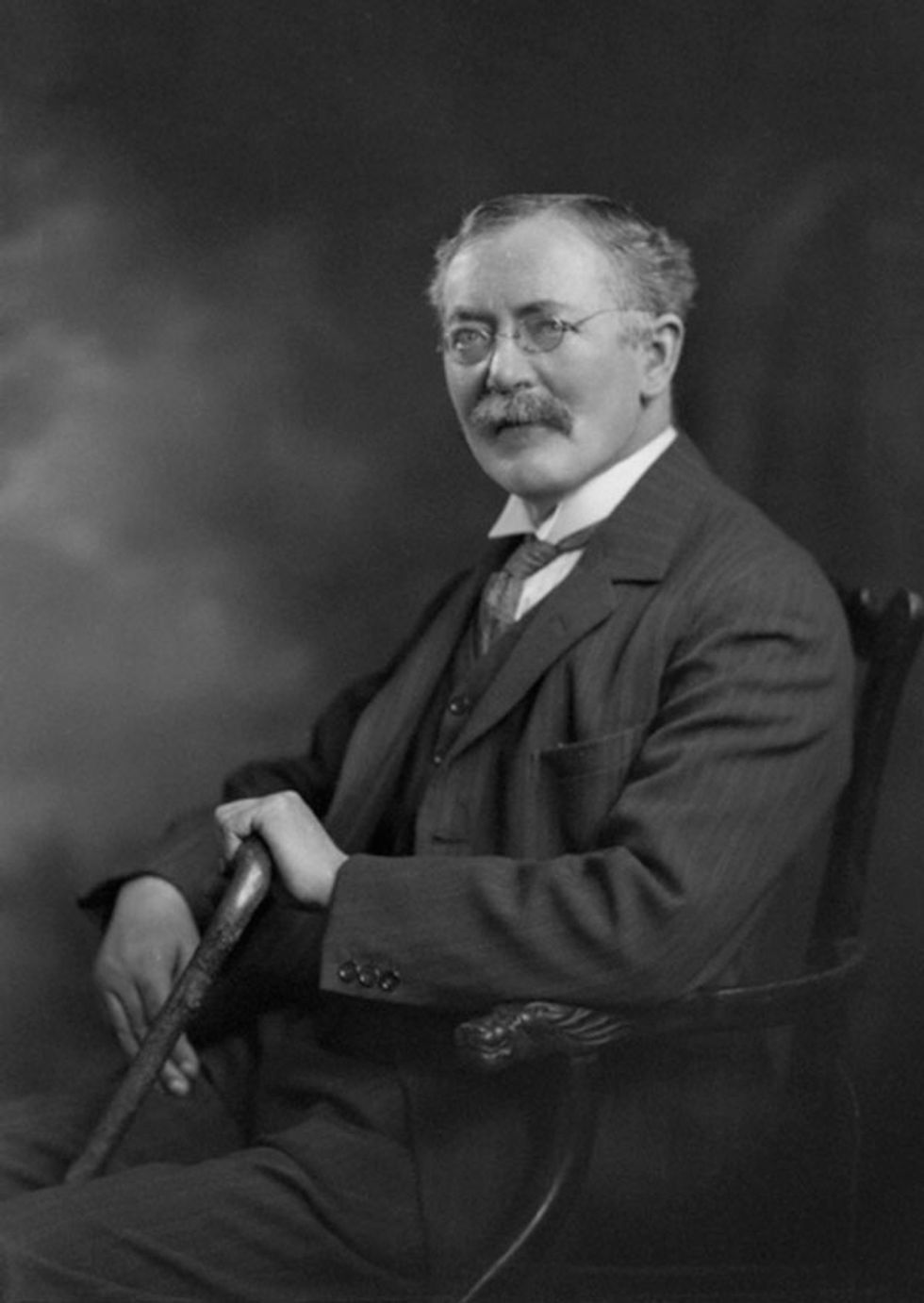
In 1897 or thereabouts, a Polish ophthalmologist named Kazimierz Noiszewski invented the electroftalm (from the Greek for “electric eye"), a device intended to help blind people “hear" their surroundings. Conceptually, Noiszewski's invention was remarkably similar to Fournier d'Albe's exploring optophone, which came later. Given his extensive research into selenium, Fournier d'Albe almost certainly would have known about the electroftalm. That may explain why he was so willing to drop the exploring optophone in favor of developing the reading optophone.
Although Fournier d'Albe excelled in many things, he was not an engineer. And so his reading optophone, while based on sound theory, took eight years and much support to move from prototype to product.
The reading optophone worked by scanning a tiny portion of the page at a time. A small rotating disk that spun at 30 rpm would break up an artificial light source into a line of five beams, each with a different frequency. When the beams were reflected onto a selenium cell, the fluctuations in light intensity would be mirrored by variations in the conductivity of the selenium. To turn the changes in conductivity into an audible signal, Fournier d'Albe used a telephone receiver from S.G. Brown Ltd that could detect fluctuations in current down to a millionth of an ampere.
The notes C, D, F, G, and B represented the frequencies of the five light beams and would mix to create different chords. As Fournier d'Albe recounted in an article for The Electrician (which he quoted in his 1924 book The Moon Element), “The two vertical strokes of [the letters] H and M give a chaos of notes, the middle stroke of N gives a falling gamut, the three horizontal strokes of E give a chord, and the curved lines of O and S give characteristic flourishes of sound." But some letters with similar visual characteristics—such as lowercase u and n—resulted in similar audio patterns that were difficult for the listener to tell apart.
Fournier d'Albe called his earliest attempt the “white sounding optophone" because he was only able to get the selenium to react to the white of the page and not the black of the letters. So the poor listener had to interpret the sounds generated by the space around each letter rather than the sounds generated by the letters themselves. With such a system, Fournier d'Albe estimated it would take around 8 hours to learn the audible alphabet and 10 to 20 lessons to discern basic words.
The white sounding optophone's deficiencies were eventually overcome in 1918, when the Scottish scientific instrument maker Barr & Stroud offered to tidy up the machine in preparation for its commercial rollout. Adding a second selenium cell, called a balancing cell, enabled the machine to read black text. [See sidebar, "How the Optophone Translated Text Into Tones."] The telephone receiver would pick up the signals from both cells and measure the difference in electrical output between them. The white signals canceled each other out so that only the black signal was magnified. The revamped machine used the notes G, E, D, and C, and lower G. This video illustrates the tones associated with the word “Type."
The Barr & Stroud machine became known as the black sounding optophone. Other design modifications included a magnifying lens for reading different sizes of text, as well as a worm thread that let the user slow the reading from 5 seconds per line to as long as 5 minutes. (Even the most experienced reader never achieved the fastest speed, as I'll discuss in a bit.) A final improvement held the book or newspaper stationary on a frame over the reading mechanism, and the reading head, or tracer, pivoted on an axis to read the line. On the white sounding optophone, the user had to keep carefully repositioning the book—a tricky task for someone who was blind.
Upon the optophone's relaunch in 1920, an exuberant Fournier d'Albe proclaimed in a letter in Nature, “It is therefore safe to say that the problem of opening the world's literature to the blind is now definitely solved."
Once again, Fournier d'Albe was overreaching. There was certainly a need for a tool like the optophone, considering the hundreds of thousands of World War I servicemen who had been blinded by gas or shells. And yet this innovative and potentially life-changing machine failed to find a foothold in the market. By the time Fournier d'Albe died in 1933, only a tiny number of optophones (perhaps as few as a dozen) had been sold.
What can account for the optophone's commercial failure? Fournier d'Albe's reputation might have contributed to the problem. Like many of his generation, he was an ardent spiritualist. It's easy for us to mock this fascination with séances and the desire to establish a connection with the dead, but we should remember the scientific breakthroughs of that era. The invisible world of electromagnetic waves and the discovery of electrons were tearing up the scientific rule book.
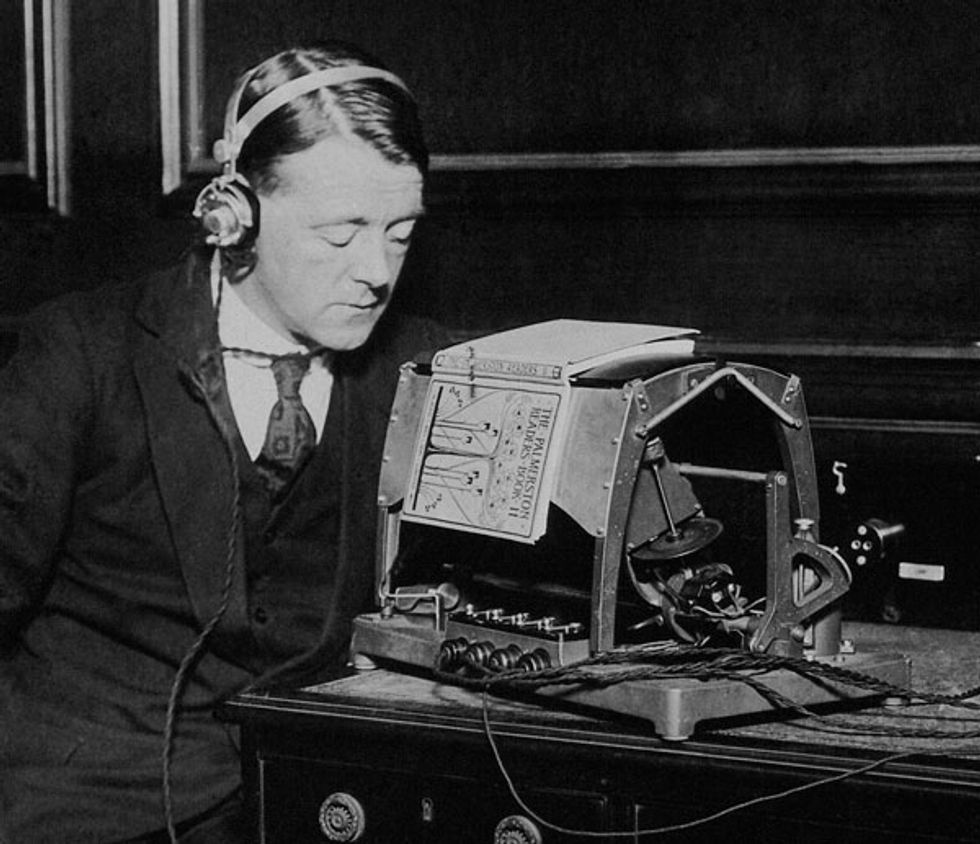
Against that backdrop, it was not a huge leap to believe that a human soul might also be stored somehow within invisible energy forces. Indeed, many hinted at this connection, but Fournier d'Albe went further, publishing a book in 1908 that made the case for the existence of “psychomeres," or soul-particles, which he said reside in human cells. He even assigned them a weight: 50 milligrams. His book prompted a backlash from the establishment. The New York Times, in a blistering critique, denounced Fournier d'Albe as a “crack-brained pseudo-scientist." He would later tone down his views on spiritualism, but some in the scientific and political mainstream continued to view him with skepticism.
For the optophone to succeed, Fournier d'Albe knew he needed the backing of the National Institute for the Blind, a powerful association that in the United Kingdom acted as the unofficial gatekeeper to his intended audience. The NIB was led by the strong-willed Arthur Pearson. Pearson had been a celebrated newspaper magnate at the start of the century, but as he slowly lost his sight due to glaucoma, he transferred his energy to supporting people who were blind. Pearson had invested heavily in providing Braille resources throughout the country, so a new machine that threatened to make Braille obsolete was never going to receive his backing.
In April 1917, the NIB agreed to send a delegation to Fournier d'Albe's lab to view a demonstration of the optophone. By the inventor's account, everything went off without a hitch, and he used the machine to accurately read a random sample from the daily newspaper at a rate of four words per minute. But when Pearson and the committee released their opinion in an open letter to the London Times a few days later, they could not have been more scathing. They concluded that the machine was little more than an interesting scientific toy—hard to learn and far too slow for any practical use. Pearson closed the letter by telling Fournier d'Albe that he should leave such inventions to “those who have the interests of the blind at heart."
Compounding the NIB's lack of support was the optophone's price. In 1917, the white sounding optophone was being offered for sale for £35 (equivalent to about US $3,500 today). When the black sounding optophone was released three years later, the price had tripled. Too expensive for the average household, it was still affordable by medical institutions. Without the backing of the NIB, however, this was unlikely to happen. In a twist of fate, the National Institute for the Blind was finally pressured into buying a single black sounding optophone in 1920 after King George V and Queen Mary saw one at an exhibition and gave it a glowing review. One of the few optophones still known to exist is in the collection of the charity Blind Veterans UK, which was founded by the man who so opposed the technology—Arthur Pearson.
One of the NIB reviewers' biggest concerns about the optophone was the amount of time required to achieve proficiency. They had a point. Fournier d'Albe had suggested that a user could learn the basics in just 10 to 20 lessons, but he was clearly overoptimistic. Most people who tried using it were able to read only a handful of words per minute—a frustratingly slow speed.
One of the machine's defenders was the renowned engineer A.A. Campbell-Swinton. He pointed out that language was a skill that people acquire slowly from infancy, so judging how quickly an adult could learn the optophone was unfair. He helped acquire several optophones to conduct a long-term assessment with a group of children, but I've found no evidence that those results were ever formally published.
By far the most successful case study began in 1918, when the inventor enlisted the help of the 18-year-old twins Mary and Margaret Jameson and taught them to use the white sounding optophone. Both already read Braille. Mary seemed more proficient with the optophone, and she ended up accompanying Fournier d'Albe on many of his public demonstrations, where she was a hit with spectators.
By 1920, Mary was up to a reading rate of 25 words per minute. She continued to use the machine for the rest of her life, reaching 60 words per minute by 1972. Sighted people can read 200 to 300 words per minute. Nevertheless, when asked in 1966 about her experience with the machine, Mary seemed untroubled by its speed and only wished that it was a bit quieter and that the selenium cells were more responsive.
Although Fournier d'Albe's beloved optophone slid into obscurity, his approach to mechanical reading inspired others. One of the first was a professor at Iowa State University named F. C. Browne, who in 1915 improved on Fournier d'Albe's idea with a device he called a phonoptikon. It used individual crystals of selenium (instead of a preparation) and a handheld wand to read the page. Although it garnered favorable press coverage, it seems to have never gone into production.
Other inventions followed. At the October 1929 Exhibition of Inventions, held in London, J. Butler Burke exhibited a device, called an optograph, that converted text into Braille. Two years later, Robert E. Naumburg of Cambridge, Mass., invented the printing visagraph, which automatically read text and embossed it on aluminum foil. The visagraph reportedly could also handle images and maps. But it was the size of a desk and took about 6 minutes to create a page. A similar machine came out in 1932. Called the photoelectrograph, it read text and embossed it onto a sheet. There was no shortage of inventors who hoped to succeed Fournier d'Albe in this new field.
Perhaps the most important legacy of the optophone came from the electronic television pioneer Vladimir Zworykin and his team at the Radio Corporation of America. During the 1910s, Zworykin had visited Fournier d'Albe to learn more about the optophone, and the visit clearly left an impression. Decades later, Zworykin would draw on Fournier d'Albe's principles to help produce a reading machine, called simply the A-2. His prototype incorporated a handheld wand and phototubes (instead of selenium) for the sensor. (Mara Mills, an associate professor of media, culture, and communication at New York University, explored the connections between Fournier d'Albe's optophone, Zworykin's reading machine, and optical character recognition in her January 2015 article, "Optophones and Musical Print," which appeared in the online publication Sounding Out!)
As in Fournier d'Albe's day, there were many thousands of injured veterans in the post–World War II era who needed tools to help them read. This time, however, the U.S. Veterans Administration (now the Department of Veterans Affairs) was keen to develop the technology, supporting RCA's efforts to refine Zworykin's design. Overseen by Leslie E. Flory and Winthrop S. Pike, RCA's new iteration, introduced in 1949, became the first machine for blind people that not only scanned text automatically but also spoke the letters and words it read.
RCA's reading machine was introduced just as electronic computers were beginning to take off. Computer scientists soon realized that the technology presented a way to speed up data processing. Indeed, many considered the RCA machine of 1949 to be the first practical optical character-recognition machine in the world. But it was Fournier d'Albe who demonstrated that such a thing was even possible. And by the 1950s, his basic approach to optical scanning was being integrated into computers around the world.
This article appears in the July 2021 print issue as “Turning Letters Into Tones."
This article was updated on 29 July 2021.
